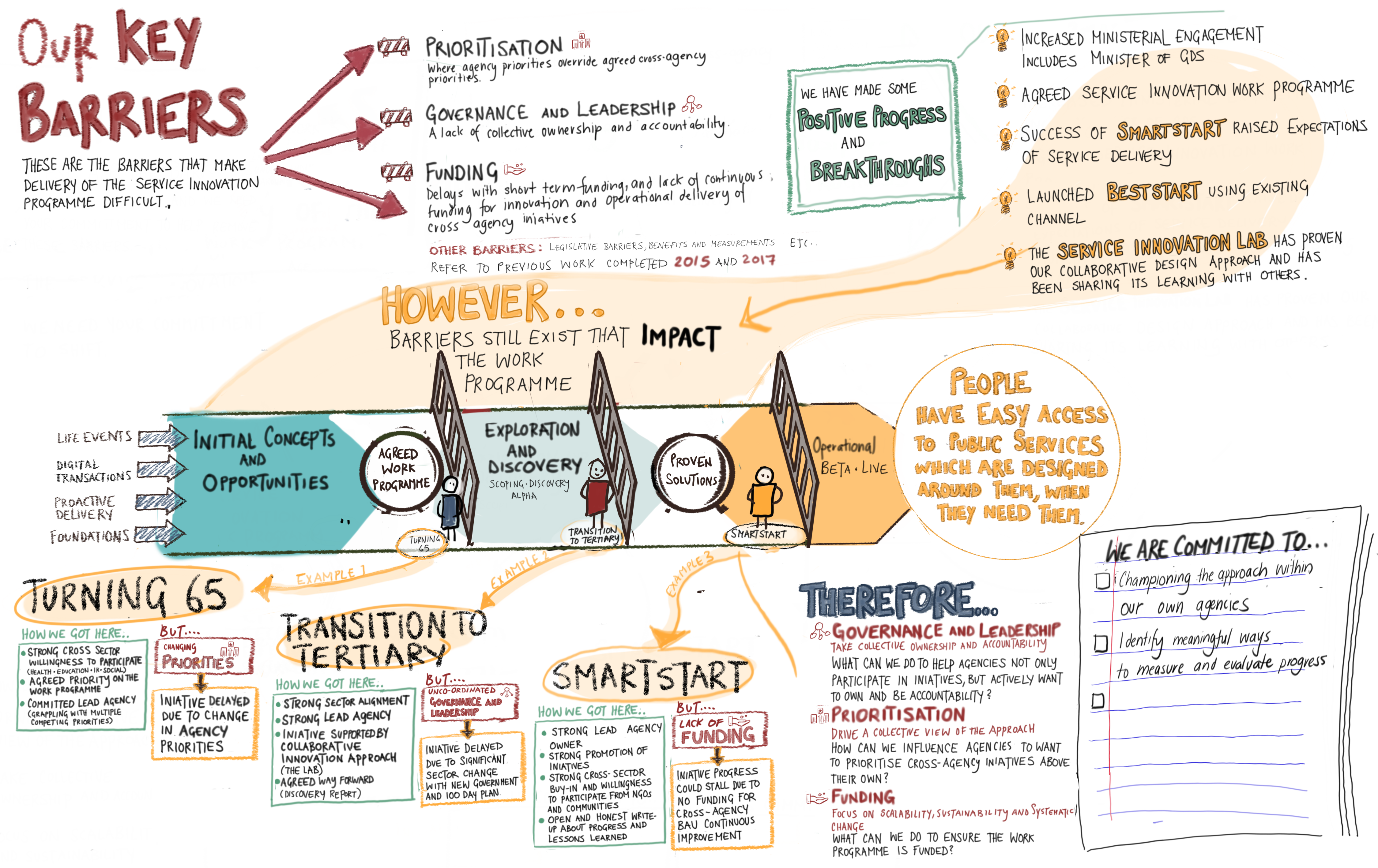Sharing what we have learned about joined-up working and public sector innovation
The following insights are a summary of reflections from the Lab team based on workshops and previous reports. Project-specific insights are also available in the project summaries shared in the projects section.
1. The importance of innovation leadership and governance
There was a clear pattern: when the governance conditions were positive, this led to collective ownership of the Lab’s work programme and a more robust mandate focused on delivery. The governance and leadership of innovation work is essential for a supportive authorising environment, especially when focusing on cross-government collaboration.
But there is a tension between the focus placed on training people in innovation processes and methods and the importance of also investing in growing capacity and capability to govern and lead innovation work in the public sector. This is reinforced by uncertain system-level incentives for collective ownership and accountability.
How might we…
- Create the conditions inside government that encourage people to explore new ways of working and safe to fail experimentation?
- Better understand the distinction between governance and commissioning for innovation versus BAU?
2. The importance of working in the spaces in-between agencies
A focus on joined-up working has placed a premium on a culture of collaboration between agencies. It required dedicated engagement roles in the team focused on building relationships, trust and joining the dots between teams and strategic priorities that otherwise would not connect.
Through a focus on integrated services, the Lab helped to join the dots but also offered expertise, resources and space to help make it happen.
While this catalytic role is crucial to fostering cross-agency working it is often difficult to measure, quantify and articulate to sponsors.
How might we…
- Recognise the value and invest in capacity and capability to work between teams and agencies to catalyse collaborative relationships and trust?
- Best measure and articulate the value of this function?
3. It’s not about the Lab space, but everyone seems to value the space
For people who worked with the Lab the concept of a dedicated (neutral) space was regularly cited as important - offering a physical space in which to collaborate, engage and work in an agile and adaptive way. Working remotely during the COVID-19 lockdown, showed that creative and participative approaches are possible digitally. Despite this, the Lab space played an important role in the Lab’s work and identity and was different from a typical office.
But rather than focus on labs, the more pertinent question may be why aren’t the characteristics of lab spaces, not the norm and where they do exist, why are they so scarce? Teams are increasingly being asked to work more collaboratively, creatively and to adopt agile practices but current workspaces don’t mirror the qualities people say they valued in the Service Innovation Lab or similar spaces.
How might we…
- Shift the focus from how innovation labs are designed to how we create workspaces that meet the needs of the work people are asked to do? Why are they so scarce?
- Apply the principles and practice of innovation labs into new settings without the need for formal/physical lab infrastructure?
4. Joined up working by design
A focus on ‘life events’ and integrated services established a work programme that required collaboration by default. As no single agency was responsible for every aspect of a life event, it needed teams to work together and recognise their interdependence. More importantly, it put the lived experience of people at the centre or the work.
But arranging government around life events with current structures presents challenges, and competing priorities creates fragility. Agency priorities can also override shared priorities. It requires people to look beyond their own agency boundaries, resources and accountabilities.
How might we…
- Develop work programmes, processes and structures that foster collaboration and joined-up working by design? What would it take?
- Create a more influential and more visible role for people/service users in policy development, implementation and delivery?
5. The precariousness of funding for new ways of working holds us back
The system-level conditions (resources, ownership, authority) for innovation work are persistently precarious and often short term for projects and labs/innovation teams. While this can be a helpful driver for innovation, in a public sector context innovation work is often grappling with complex long-term issues.
But short-term funding cycles often lead to time and effort being diverted toward justifying continued support and funding and away from the work itself. It can create pressures to focus on quick wins and justifying the work, over system-level change and a longer-term focus.
How might we…
- Develop approaches to funding and resourcing labs and innovation teams that incentivise long term thinking and outcomes?
- Better demonstrate value and impact in the short term that supports a long-term approach?


